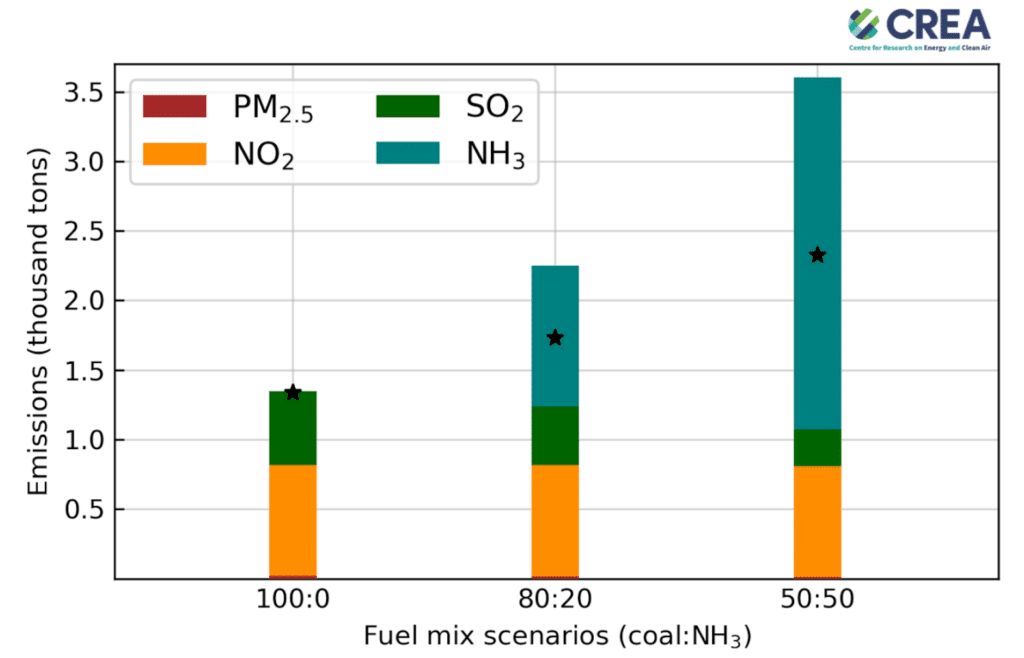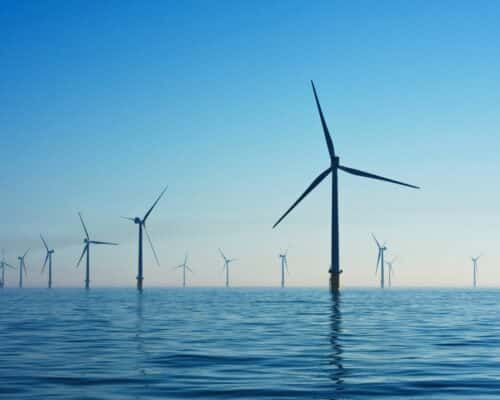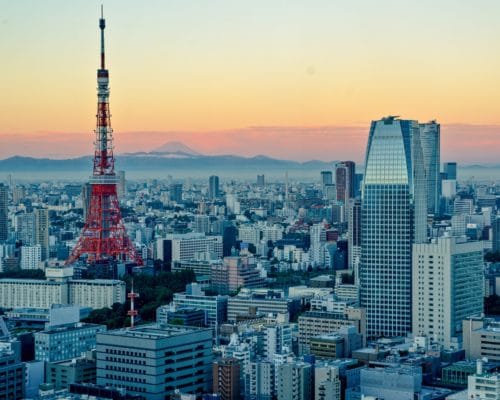The Environmental and Climate Impacts of False Solutions on Japan
16 April 2024 – by Viktor Tachev Comments (0)
Under the Green Transformation Strategy (GX), Japan aims to raise over USD 1.1 trillion to support the development and deployment of hydrogen, ammonia, CCS and gas technologies domestically and across Southeast Asia. The fossil fuel-based nature of these technologies has led experts to describe them as “false solutions” to climate change. Since the spotlight has been primarily on their limited decarbonisation potential, the environmental and climate impacts of their mass adoption for power generation have remained underreported. However, scientists warn that it could lead to increased air pollution and adverse health consequences.
The Hydrogen-Ammonia Co-firing and CCS Plans of Japan
The Ministry of Economy, Trade and Industry estimates Japan’s demand for ammonia as a fuel at 30 million tonnes annually by 2050. The country plans for hydrogen and ammonia to make up 1% of its primary energy mix by 2030.
Starting in 2024, Japanese companies producing clean hydrogen, ammonia or synthetic fuels will be eligible to apply for government funding. Furthermore, through a new law, the administration will provide more stable legal grounds for developing CCS technology.
However, ammonia and hydrogen projects across the country are already being developed.
In 2022, the Japanese government announced plans to fund four ammonia energy pilot projects. The projects will receive funding under the Fuel Ammonia Supply Chain Construction Project. By 2030, the initiative aims to introduce 20-40 ammonia combustion units for electricity generation, both co-firing and mono-firing types.
In 2023, INPEX Corporation launched Japan’s first demonstration project for the domestic production of blue hydrogen/ammonia, implementation of CCUS in local, depleted gas fields and the use of hydrogen for power generation and ammonia production. It aims to launch in 2025.
Idemitsu Kosan announced plans to build an ammonia import terminal using the existing infrastructure at the Tokuyama plant in western Japan and supply more than 1 million tonnes of low-carbon ammonia by 2030.
Mitsubishi is considering turning part of its liquefied petroleum gas terminal in Namikata into an ammonia terminal and supplying low-carbon ammonia for industrial use.
Between March and June 2024, JERA plans to co-fire 20% of ammonia with coal at its Hekinan thermal power station. Japan’s top power generator aims to start ammonia co-firing on a commercial basis at the Hekinan No. 4 unit by 2027. The company also aims to try replacing 50% of its coal with ammonia at the No. 5 unit in around 2028.
Japanese companies, including Japan Petroleum Exploration Co., Mitsubishi Gas Chemical Co., IHI Corporation, Mitsui & Co. and Mitsui O.S.K. Lines (MOL), will begin research on ammonia and coal co-firing at thermal plants. They will partner with power generation companies, steel companies, paper companies, chemical companies and other businesses.
Various other domestic projects are also in the making, with more to come in the future. Five domestic CCS projects are also planned at various power and industrial plants across the country.
Why Experts Brand Japan’s Technologies as ‘False Solutions’
Instead of retiring fossil fuel infrastructure, as the IEA, IPCC, and the Academies of the Group of Seven (G7) have repeatedly called for, Japan is looking to extend its life through co-firing and CCS technologies.
However, according to the Breakthrough Institute, ammonia and hydrogen co-firing may result in more emissions than simply burning coal or gas.
TransitionZero finds that Japan’s goal of 20% ammonia co-firing at domestic coal power plants by 2030 will still generate nearly double the emissions of standard gas-fired power plants. In Southeast Asian countries, the figures are even higher. Even 50% ammonia co-firing schemes would emit comparable emissions to gas power generation.
Ammonia Co-Firing Associated With Increased Environmental and Climate Impacts
While Japan has made deals for imports of green ammonia, the announced domestic projects will use primarily blue and grey, which are derived from natural gas. However, research suggests that aside from the limited decarbonisation potential, ammonia co-firing and the accompanying technologies, like CCS, also pose environmental and health risks due to air pollution and water contamination through the escape of unburnt ammonia, nitrogen oxide release and fine particulate matter (PM2.5) pollution from ammonia co-firing schemes in coal plants.
After estimating the emissions for JERA’s Hekinan Thermal Power Station Unit No. 4, Japan’s largest coal-fired power plant, which has been revamped to use both coal and ammonia, the Center for Research on Energy and Clean Air (CREA) finds that firing coal with ammonia substantially increases total pollutant emissions. For example, a 20% ammonia co-firing combustion rate can increase PM2.5 and other harmful substances by 67%. At a 50% co-firing rate, the increase is 167%.

The Ministry of Economy, Trade and Industry and JERA both claimed that ammonia co-firing in thermal power plants won’t increase pollution.
However, the team behind the study reach different conclusions. “Our results indicate that Japanese improvements in air quality could be undermined, or even offset, by replacing coal,’’ the authors said. They also said that due to ammonia-coal co-firing, it would be highly likely that the emissions from the Hekinan power station could affect PM2.5 concentrations in nearby cities.
Long-term exposure to PM2.5 leads to various adverse health conditions. According to the State of Global Air, they include ischemic heart attacks, lung cancer, respiratory infections, stroke, Type 2 diabetes and adverse birth outcomes such as autism.
Aside from PM2.5, ammonia co-firing produces other harmful emissions, including sulphur dioxide and nitrogen dioxide, with which Japan already has a problem. The technology also poses ecosystem and water contamination risks.
False Solutions Can Worsen the Climate and Environmental Issues in Japan
Around 92% of those living in the Asia Pacific are exposed to air pollution levels that endanger their health. According to research, South and East Asia are experiencing high numbers of deaths due to long-term exposure to air pollution. Globally, 5.13 million excess deaths per year are attributable to ambient air pollution from fossil fuel use. Phasing out fossil fuels could potentially avoid them.

According to the State of Global Air, very few countries globally are seeing an increase in PM2.5 exposure today. Between 2010 and 2019, the only ones were Japan, Nigeria, Bangladesh, India, and Pakistan. Of those, Japan saw the most significant increase in PM2.5 exposure, with 17%. For comparison, the increase in Bangladesh, India and Pakistan, three countries often known for bad air quality, was 12%, 8.5% and 5%, respectively.
Between 2010 and 2019, the number of deaths attributable to PM2.5 in Japan increased by 33.5%. Today, fine particulate matter is responsible for 43,000 premature deaths per year.
Estimates suggest that by 2060, outdoor air pollution will cause 779 deaths per year per million people in Japan. It caused 468 in 2010.

Increased Climate Risk
As an island nation, Japan is particularly vulnerable to climate-related extreme weather events. Among them are typhoons, flooding, sea level rise and heat waves.
Scientific research says that Japan will experience worsening climate impacts if it follows a high-emissions pathway.
Climate Action Tracker notes that Japan’s climate policies and actions need substantial improvements to align with the 1.5°C target. If all countries followed a similar approach, warming would reach over 2°C and even up to 3°C.
At a 2.4°C temperature increase, for example, rising sea levels, coastal erosion and changing storm patterns would expose 4 million Japanese people to devastating floods by 2050. The Kii Peninsula, in particular, could face over 3,000 mm of rain yearly, becoming the world’s rainiest subtropical area.
These predictions have already started to materialise. For example, a rain-induced flood in 2018 forced millions of people to evacuate and caused over 200 deaths.
In the summer of 2023, 128 locations across Japan saw record-high temperatures, many setting new consecutive records for extreme heat. The temperature was 1.78°C above average, beating the 2010 record of 1.08°C. Nearly 50,000 people needed emergency medical attention in July alone, with at least 53 dying of heatstroke.
This wasn’t just a one-off event but a clear pattern. In 2022, nearly 4,500 people were hospitalised with heat-related issues. In 2019, 57 people died, and more than 18,000 were hospitalised. Meanwhile, the death toll in 2018 was 138, with over 71,000 people sent to hospitals.
Heatwaves are expected to become more common in the future. Paired with the associated heatstroke risk, they are particularly dangerous for Japan since it has the second oldest population in the world.
Japan’s Strategy Could Prove Costly for the Country’s Climate Goals
Japan has long been aware of the impact of global warming. Yet, it ranks 58th on the Global Climate Change Performance Index, with a very low rating.
The country’s proposed decarbonisation technologies, which experts have described as “a way to legitimise coal in the eyes of financiers and lenders”, have been subject to criticism from civil society groups and even fellow G7 peers. According to experts, the push for these technologies is influenced by corporate interests and the country’s fossil fuel lobby. Analysts suggest that some of their biggest supporters are also among Japan’s leading emitters.
At COP28, the global environmental group Climate Action Network awarded Japan two “Fossil Awards” for its status as a climate change policy laggard for the fourth consecutive year. French President Emmanuel Macron urged Japan to “put an end” to coal-fired power generation by 2030.
Japan’s leadership has so far been unfazed by international criticism. It insists that leveraging its technologies can reduce global GHG emissions. However, the environmental and climate risks and their already-evident implications are sufficient arguments to change course.
by Viktor Tachev
Viktor has years of experience in financial markets and energy finance, working as a marketing consultant and content creator for leading institutions, NGOs, and tech startups. He is a regular contributor to knowledge hubs and magazines, tackling the latest trends in sustainability and green energy.
Read more







